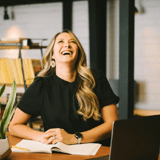Summary
The highest-performing teams have one thing in common: psychological safety — the shared belief that no one on the team will embarrass or punish anyone else for admitting a mistake, asking a question, or offering a new idea. Studies show that psychological safety allows for moderate risk-taking, speaking your mind, creativity, and collaboration — just the types of behavior that lead to successful products and services. Creating psychological safety in a workplace - although at times a challenge - can be done. This interactive talk will present the key action steps that DesignOps professionals can immediately take to boost psychological safety in their design teams and create psychological safety between cross-functional teams.
Key Insights
-
•
Psychological safety is a neurobiological state governed by the autonomic nervous system, reflecting connection and calm.
-
•
Trust and safety differ: safety is a nervous system state, while trust is about relational dynamics.
-
•
Our nervous system moves up and down the 'autonomic ladder' from safe to mobilized (fight/flight) to immobilized (shutdown), impacting thinking and behavior.
-
•
Triggers at work like unexpected meetings, criticism, and toxic vulnerability can push people down the ladder, impairing performance.
-
•
Google’s Project Aristotle found psychological safety, not individual talent, is the key driver of effective, high-performing teams.
-
•
Creating safety requires explicit conversations about what makes individuals feel safe and crafting specific, observable team agreements.
-
•
Connection and co-regulation with others help individuals move back up the autonomic ladder after being triggered.
-
•
Safety includes protections, especially for marginalized groups who face greater systemic risks impacting their ability to be vulnerable.
-
•
Remote work amplifies existing culture; good cultures adapt and maintain safety remotely, toxic cultures worsen.
-
•
Leadership accountability and willingness to acknowledge mistakes are vital to rebuilding trust and psychological safety after breaches.
Notable Quotes
"Safety is a state of our nervous system, when our autonomic nervous system is in a safe state, we feel connected."
"If I make a mistake on our team, it’s not gonna be held against me; my team won’t disconnect from me."
"Our nervous system is ancient; it can’t tell the difference between an angry email and a tiger lurking."
"Psychological safety is the number one factor determining team effectiveness and performance."
"When we’re not safe, our thinking brain — the neocortex — shuts down and operating IQ drops by half."
"Connection means feeling seen, heard, and valued; that’s what creates psychological safety."
"Psychological safety is the foundation; without it you get a culture of transaction and silence."
"Sometimes the entire leadership team quitting at once is a big sign cultural safety is failing."
"Creating safety requires specific, behavioral agreements you can observe and practice."
"Co-regulation means someone who is safe can help bring another out of a triggered state."
Or choose a question:















More Videos

"There’s no faking it with this crowd."
Doug PowellClosing Keynote: Design at Scale
November 8, 2018

"If a group session with middle schoolers goes off the rails, one-on-one sessions can save the research."
Mila Kuznetsova Lucy DentonHow Lessons Learned from Our Youngest Users Can Help Us Evolve our Practices
March 9, 2022

"In Toronto it’s now illegal to transmit a Wi-Fi signal in designated public spaces, with penalties for violations—a policy driven by people wanting to unplug from digital life."
Sarah GallimoreInspire Progress with Artifacts from the Future
November 18, 2022

"If your users are happy, that anecdotal feedback often carries more weight early than quantitative metrics."
Lada Gorlenko Sharbani Dhar Sébastien Malo Rob Mitzel Ivana Ng Michal Anne RogondinoTheme 1: Discussion
January 8, 2024

"It is our job to lead and transform with empathy and heart because there’s fear in everyone."
Alnie FigueroaThe Future of Design Operations: Transforming Our Craft
September 10, 2025

"Every board member can interpret an NPS score differently depending on their role and responsibilities."
Landon BarnesAre My Research Findings Actually Meaningful?
March 10, 2022

"Every workaround is a mini story of somebody overcoming an obstacle."
Emily EagleCan't Rewind: Radio and Retail
June 3, 2019

"Designing for change means focusing on learnability and product consumability, not just ease of use."
Malini RaoLessons Learned from a 4-year Product Re-platforming Journey
June 9, 2021

"I learned to be relentless about prioritization and to hone in on specific details and use cases."
Asia HoePartnering with Product: A Journey from Junior to Senior Design
November 29, 2023
















